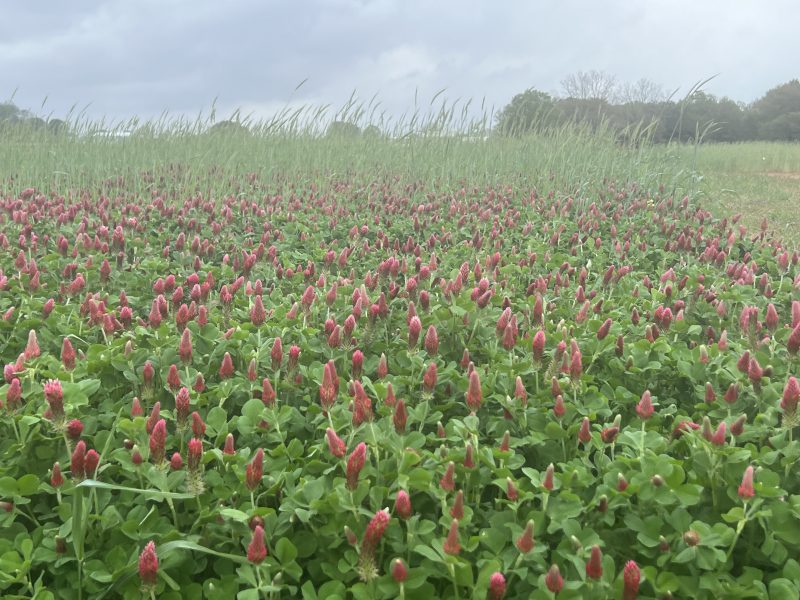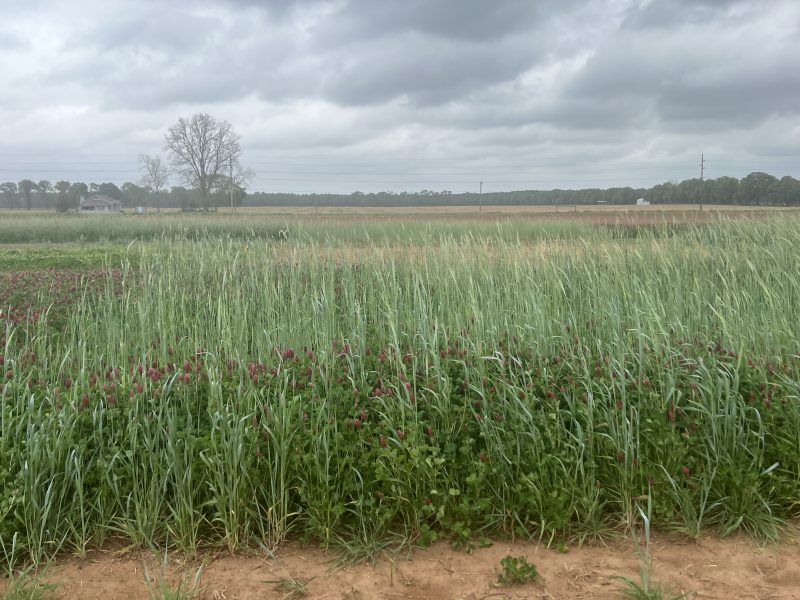Introduction
As the Florida Panhandle transitions into fall, farmers are finishing up summer crops and preparing for the winter months. This is an ideal time to plant cover crops, which serve as a critical tool for soil conservation, nutrient management, and improving overall field health. Winter cover crops, including cereal rye, crimson clover, hairy vetch, and oats, offer multiple benefits for sandy soils prevalent in our region. Beyond preventing erosion, these crops enhance soil organic matter, capture residual nutrients, and support beneficial microbial communities. For farmers committed to sustainable practices and long-term productivity, incorporating cover crops now sets the foundation for healthier soils and stronger yields in 2026.
–
Benefits of Winter Cover Crops

Figure 1. Crop residue help protect soil from wind and water erosion even at the end of the summer crop season, as seen in this cotton field. Credit: Hardeep Singh, UF/IFAS
- Erosion Control:
The Florida Panhandle’s sandy soils are highly susceptible to wind and water erosion, especially after harvesting summer crops. Cover crops provide a protective vegetative layer that reduces soil loss and protects fields from runoff.
– - Nutrient Management:
Non-leguminous cover crops scavenge residual nitrogen, preventing leaching into waterways. Leguminous species like crimson clover and hairy vetch fix atmospheric nitrogen, naturally enriching the soil for future crops.
– - Soil Structure and Organic Matter:
Roots of cover crops improve soil aggregation and porosity, enhancing water infiltration and reducing compaction. As these plants decompose, they add organic matter, improving nutrient retention and soil fertility.
– - Weed Suppression and Pest Management:
Dense cover crop stands compete with winter weeds, reducing herbicide needs. Some species also provide habitat for beneficial insects that can help manage pests in subsequent crops. For example, rye as cover crop is very effective in weed suppression due to allelopathic effects and high biomass production. Figure 1 (right) demonstrates the persistent biomass of cereal rye in cotton at time of cotton harvest.
–
Planting and Management Guidelines
- Timing: Aim to plant cover crops as soon as summer crops are harvested, typically late October through early November. Early planting improves establishment before colder temperatures.
– - Seeding Rates: Adjust seeding rates based on species and field conditions. Adjust seeding rate for method & seed quality: if broadcasting, increase rate ~25–30% vs. drilling; adjust also for percent pure live seed.
– - Planting cover crop mixtures: Mixtures are often most reliable in sandy coastal soils (like the Florida Panhandle): a grass + legume blend scavenges residual N, builds biomass, and supplies more balanced N release.
–

Notes on biomass ranges and nitrogen values: biomass is highly site-specific (planting date, soil, moisture, termination timing). Values above are approximate field ranges reported in different research and extension materials from UF, UGA and Auburn University; use them for planning purposes only.
–
This fall, we are ready to plant a research trial testing several winter cash cover crops at the West Florida Research and Education Center (WFREC), including wheat, oats, barley, and rye. The goal of this trial is to evaluate crop performance, biomass production, grain production and what impact inclusion of these winter crops will have on summer crop (cotton and peanuts) performance under local conditions. In the coming years, we plan to expand this trial to on-farm locations across the region, allowing us to evaluate these cover crops under a broader range of soil types, management practices, and production systems. These efforts will help provide practical recommendations for Southeastern growers interested in integrating winter cover crops into their rotations.
–

Crimson Clover monoculture growing in research plots at WFREC, Jay, FL. Credit: Hardeep Singh, UF/IFAS
–
Winter cover crops offer Florida Panhandle farmers a practical, research-backed method to protect sandy soils, improve nutrient use efficiency, and build long-term fertility. By carefully selecting species, planting at the right time, and managing cover crops effectively, growers can enhance soil health, reduce input costs, and improve yields for the next season. Whether using cereal rye for erosion control, crimson clover for nitrogen fixation, or mixed stands for maximum benefit, incorporating cover crops into a rotation is an investment in sustainable, resilient agriculture.
- Potential Winter Cover Crops and Best Management Practices - November 7, 2025
- Managing Peanut Vine Growth with Plant Growth Regulators - May 2, 2025
- Join the 2025 STEP Cotton Competition! - March 28, 2025

